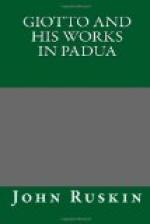The incidents represented in these first twelve paintings are recorded in the two apocryphal gospels known as the “Protevangelion” and “Gospel of St. Mary."[13] But on comparing the statements in these writings (which, by the by, are in nowise consistent with each other) with the paintings in the Arena Chapel, it appeared to me that Giotto must occasionally have followed some more detailed traditions than are furnished by either of them; seeing that of one or two subjects the apocryphal gospels gave no distinct or sufficient explanation. Fortunately, however, in the course of some other researches, I met with a manuscript in the British Museum (Harl. 3571,) containing a complete “History of the most Holy Family,” written in Northern Italian of about the middle of the 14th century; and appearing to be one of the forms of the legend which Giotto has occasionally followed in preference to the statements of the Protevangelion. I have therefore, in illustration of the paintings, given, when it seemed useful, some portions of this manuscript; and these, with one or two verses of the commonly received accounts, will be found generally enough to interpret sufficiently the meaning of the painter.
[Footnote 13: It has always appeared strange to me, that ecclesiastical history should possess no more authentic records of the life of the Virgin, before the period at which the narrative of St. Luke commences, than these apocryphal gospels, which are as wretched in style as untrustworthy in matter; and are evidently nothing more than a collection, in rude imitation of the style of the Evangelists, of such floating traditions as became current among the weak Christians of the earlier ages, when their inquiries respecting the history of Mary were met by the obscurity under which the Divine will had veiled her humble person and character. There must always be something painful, to those who are familiar with the Scriptures, in reading these feeble and foolish mockeries of the manner of the inspired writers; but it will be proper, nevertheless, to give the exact words in which the scenes represented by Giotto were recorded to him.]




